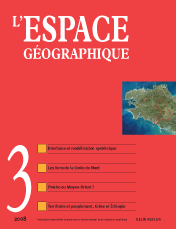

GROUPE DE RECHERCHES «INTERFACES». The interface: contribution to the analysis of geographical space
This article conveys the scientific positioning of a group of researchers on the concept of interface in geography. It provides a definition and scope for interface that distinguish it from related concepts like discontinuity and limit. It also aims to show how the concept of interface can be used to analyse structures and dynamic space, by emphasising exchange and regulation processes. In order to make the concept more operational, a specific system for interpreting interfaces and their working consequences is suggested.
keywords: DISCONTINUITY, EXCHANGE, INTERFACE, LIMIT, REGULATION, SPACE SYSTEM
North Korea’s maritime connections: territorial change on the Korean peninsula and regional dynamics in North-East Asia (4 fig., 4 tabl.)
Through quantitative data extracted from Lloyd’s insurance group, this paper analyses the evolution of vessel movements through North Korean ports from 1985 to 2005. Results show how ongoing inter-Korean economic integration and the internal difficulties of the North Korean transport system foster North-South maritime connections. Against a backdrop of North Korean economic reforms and growing interrelations between the two Koreas, the shift of North Korean main traffic to Chinese and South Korea transit ports (hubs) illustrates changing trade relations, the contraction of North Korea’s economic space, and also practices of ocean carriers, who tend to concentrate their services on the nearest ports with best infrastructure.
keywords: FLOWS, NORTH KOREA, PORT, REGIONAL INTEGRATION, SOUTH KOREA
Near East or Middle East? Geohistory of the concept of Middle East (3 fig.)
The fact that the two French concepts of Proche-Orient (Near East) and Moyen-Orient (Middle East) are often used interchangeably causes further confusion about an already complex, unstable region. While is probably impossible to enforce rules of usage, these could be better defined. This paper attempts to do that through a geohistoric analysis of the English concept of Middle East. The Middle East seems to be central to both the English and the French conceptual systems, a central toponym, which could be seen as a reflection of the geographically central position of the Middle East region in the Old World.
keywords: GEOHISTORY, MIDDLE EAST, NEAR EAST
The Ethiopian patchwork. Territorialisation in North Omo, Southern Ethiopia (1 fig.)
Through the case of Southern Ethiopia, this article examines the territorial process by looking at the conditions of territorialisation: patterns of territorial construction and chronological dimension of the process. The demonstration focuses on how previous territorial or spatial divisions are integrated into the current territorial construction The transition from one administration to another is a key factor in territorialisation. In a sense, building and owning a territory depends as much on the ability to assimilate previous administrative divisions as on the invention of new territorial standards.
keywords: ADMINISTRATION, HISTORY, STATE, TERRITORY
Interpreting the results of the Greek census of 2001. Changes in population distribution and spatial practices on the Greek territory (7 fig., 3 tabl.)
The results of the 29th census of the Greek population conducted on 18 March 2001 provide an accurate picture of population distribution within the country. The census confirmed that the population is spatially concentrated in a few, mostly coastal, areas of the Greek territory. However, a geographical comparison of the different categories used (de facto population versus resident population; nationals versus foreigners) helps shed new light on the population trends that are reshaping the population distribution and the social uses of the Greek territory at the beginning of the 21st century.
keywords: CENSUS, GREECE, MIGRATION, POPULATION, TERRITORY
Systemic approach of the functioning of a landscape (8 fig., 4 tabl.)
This article describes a systemic approach to the functioning of a hedgerow landscape with environmental implications. After analysing land-use/land-cover and landscape trends, identifying and ranking the driving forces of change, the systemic analysis highlights the scales of change and the stakeholders involved in the evolution of these landscapes. This approach shows the complexity of land-use change processes in intensive agricultural areas with a highly fragmented landscape. It is an essential preliminary step in simulating future changes in agricultural practices and evaluating their environmental impacts. This is key to the implementation of sustainable policies.
keywords: DRIVING FORCE, INTENSIVE AGRICULTURE, LANDSCAPE FEATURE, LAND USE
Book reviews
In this issue of l’Espace géographique, you will find critical reviews of the following books
RENARD J. (2005). La Vendée, un demi-siècle d’observation d’un géographe. Paris: Presses universitaires de Rennes, 308 p. (Armand FRÉMONT, Paris)
L’espace géographique 2/08![]()
![]() L’espace géographique 4/08
L’espace géographique 4/08
For subscribe or buy this issue: BELIN
![]() L’Espace géographique: contents
L’Espace géographique: contents
Last modified: October 9, 2008